An Inside Look at Apple Park
An exclusive look at one of the most modern and environmentally friendly offices in the world.
As the world’s largest and (purportedly) most environmentally-friendly office building, Apple’s main corporate HQ in Cupertino, California has been billed “the ultimate Apple product.”
However, these accolades haven’t prevented Apple employees from staging an ongoing campaign to stay away from the office. After the campus closed due to the COVID-19 pandemic, staffers wrote multiple letters to executive management petitioning for permanent WFH options after Apple leadership demanded employees work from the office at least three days a week once the campus reopens (that date is still uncertain due to the Delta variant).
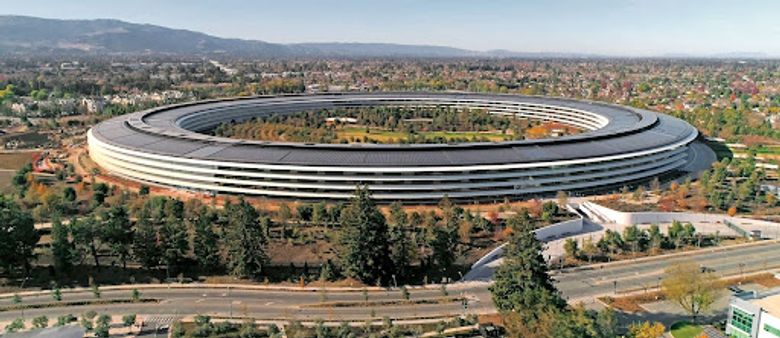
Photo credit: Arquitectura Viva
In fact, Apple’s campus—and its longstanding aversion to remote work—is built around the popular misconception among tech companies that chance collisions with coworkers while hot-desking on a massive campus is what begets new ideas and innovation.
In 2018, Apple was the first US company to hit a $1 trillion valuation. The $5 billion campus (the main building alone is worth $4.17 billion) is but a drop in the bucket for a company whose market cap has more than doubled since then.
Where the old campus comprised a series of siloed buildings, Apple’s newest HQ, named Apple Park, represents a “unified perfection.” The main building is entirely circular, earning it nicknames like “the spaceship” and more commonly “The Ring.” While it represents the late Apple co-founder Steve Jobs’ wish to unite engineers, designers, and product teams together under one roof, the ring design seems like a physical ode to Apple’s commitment to secrecy—either you’re in the circle, or you’re out.
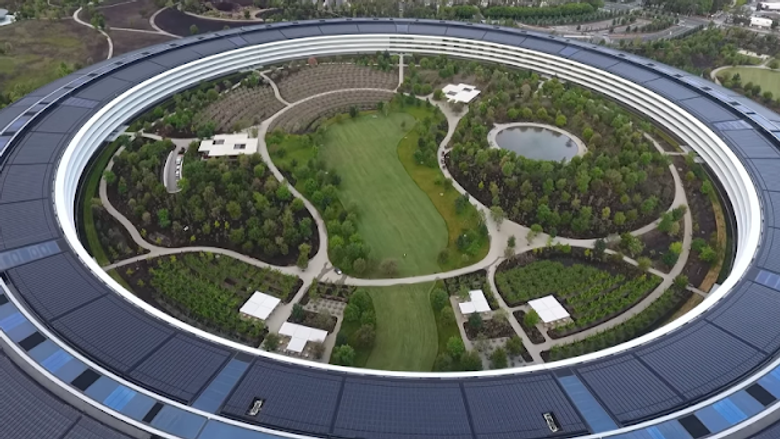
Photo credit: Pinterest
However, in public comments regarding Apple Park, Jobs, who was heavily involved in the building’s construction in the last two years before his passing in 2011, maintained that the design ethos was to make the campus look less like a business park and more like a nature refuge.
Eighty percent of the 175-acre site features green space, and is planted with 9,000 drought-resistant trees—cherry, apricot, olive, persimmon, and, of course, several varieties of apples—and plants indigenous to the Cupertino area. Artificial hills “play an essential role on the site,” according to audio from a guided tour provided to Apple employees via an internal app called Tour Apple Park, which helps new staffers navigate the campus.
“[The hills] bring Steve’s vision for Apple Park to life. From our first conversations about the campus, there was this emphasis from him on health and having jogging trails. That was a directive. The notion that it’s good for you to go outside, it’s good for you to have to walk between your car and your desk. That was very clear from him.”
Prior to this impressive feat of engineered topography, the land was little more than a flat parking facility dotted with corporate sheds. After acquiring the land from Hewlett-Packard for $160 million (incidentally, a company where Steve Jobs was once a summer intern), Apple increased the green space from 20% to 80% and added over four miles of walking and jogging trails.
The lowdown on the spaceship
The circular building features walls made from eight hundred 45-foot-tall curved glass panels that connect all the way around the four-story structure—the largest sheets of curved glass ever constructed. Some of these glass panels function as sliding doors, allowing for the interior to be exposed to the outdoors when weather permits.
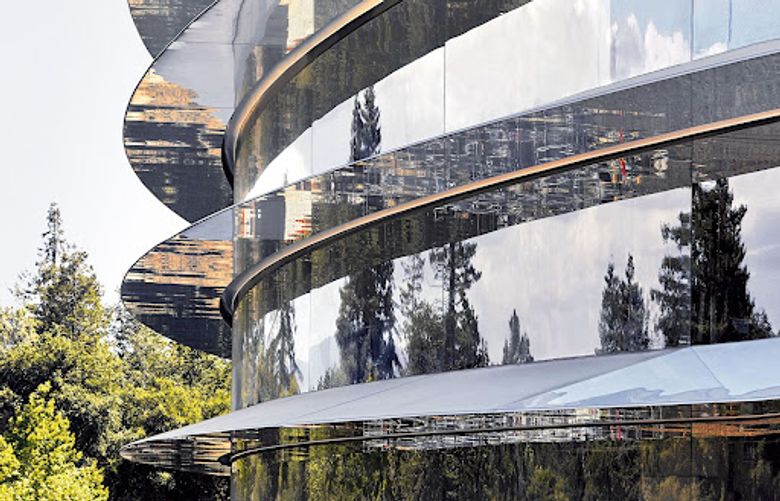
Photo credit: Arquitectura Viva
Housing 12,000 employees over 2.18 million square feet of office space, the building is “essentially a 50-60-storey tower tipped on its side and twisted into a circle,” wrote Nick Compton, contributing editor for Wallpaper magazine.
Jobs acknowledged in an interview that the building’s circular design was “not the cheapest way to build something.” The Ring comprises eight identical segments, each one consisting of communal “pod” spaces for collaboration, private offices for heads-down work, a central atrium, and walls that can be reconfigured to create large open spaces or smaller private offices.
“All desks are height-adjustable and cabling has been sunk into the lifting mechanism, built in the same brushed aluminum as Apple’s Macbooks,” Compton wrote. “The corridor is dotted with Eero Saarinen ‘Womb’ chairs to encourage off-the-cuff conversation while taking in the views.”

Photo credit: Arquitectura Viva
The stairs, made of lightweight cast concrete, at the Apple campus are a special point of pride, having been designed by Jony Ive, Apple’s chief design officer at the time, who became heavily involved in the construction and design of the new campus, working closely with design firm Foster+Partners.
Workers sit in clusters by department in a wide variety of office types, emphasizing a democratic, non-hierarchical culture where information can be easily shared. Like at Facebook, the design ethos behind the Apple campus is to commingle employees from different teams rather than cloistering them. So instead of physically disconnected design studios, everyone shares one studio.
“We can have industrial designers sat next to a font designer, sat next to a sound designer, who is sat next to a motion graphics expert, who is sat next to a color designer, who is sat next to somebody who is developing objects in soft materials,” Ives said in an interview with Wallpaper magazine.
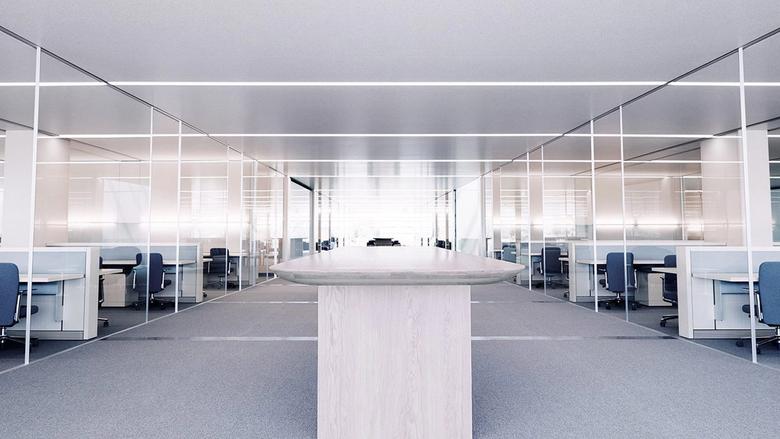
Photo credit: Dezeen
Despite the designers’ insistence on encouraging teams to cross-collaborate, secrecy remains the primary modus operandi at Apple. Two employees who are not on the same exec team can’t talk about what they’re working on.
“Even senior engineers have no idea what a final Apple product will look like until it is launched,” according to one Quora user. “The people who work on the software have no idea what the hardware is like, and the hardware guys don’t know anything about the software.”
Impressive environmental accolades
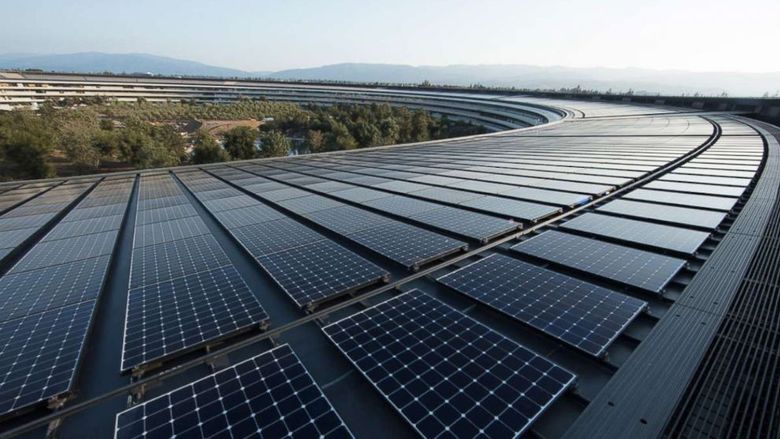
Photo credit: ABC News
The entire Apple campus is powered by 100% renewable energy. Solar panels covering the entire roof generate 80% of the building’s energy needs, representing one of the world’s largest rooftop solar farms. The rest of the campus’s energy needs are met by onsite fuel cells powered by biofuel and natural gas. It is the largest naturally ventilated building ever, meaning it requires no heating or cooling for nine months out of the year, making it the greenest office building in the world. The ventilation keeps the building between 68-77 degrees Fahrenheit for most of the year.
Until recently, The Ring was the largest LEED Platinum-certified office building in North America, before it was beat out by the iconic Willis Tower in Chicago. Critics counter that Apple’s claim to a minimal carbon footprint is offset by the fact that the campus has a multi-story, subterranean parking garage with space for a whopping 11,000 vehicles.
Apple’s gently undulating hills, which give its central courtyard the appearance of a golf course when viewed from above, were made from the earth that was removed to make way for the building’s earthquake-proof foundations. Inspired by Japanese building design, the Apple campus is situated on a foundation that uses “base isolation” technology, which essentially means the entire building sits on 700 stainless steel saucers designed to protect the building’s foundation from natural disasters. In the event of an earthquake, the entire campus can shift up to four feet on those saucers, reducing earthquake shaking by as much as 80%.
Other things to look out for at Apple Park
The Restaurant
The Restaurant is the campus town square, occupying the Ring’s entire northeast axis. The quadruple-height dining hall is enclosed by the largest glass doors in existence, designed to “increase the sense of landscaping sweeping through the building,” according to Foster+Partners. The doors are 50 feet high and 180 feet wide (that’s four stories tall, BTW), and roll on tracks hidden beneath the floor. Watching these massive doors slide open is a dramatic sight to behold, per this tweet from Apple CEO Tim Cook.
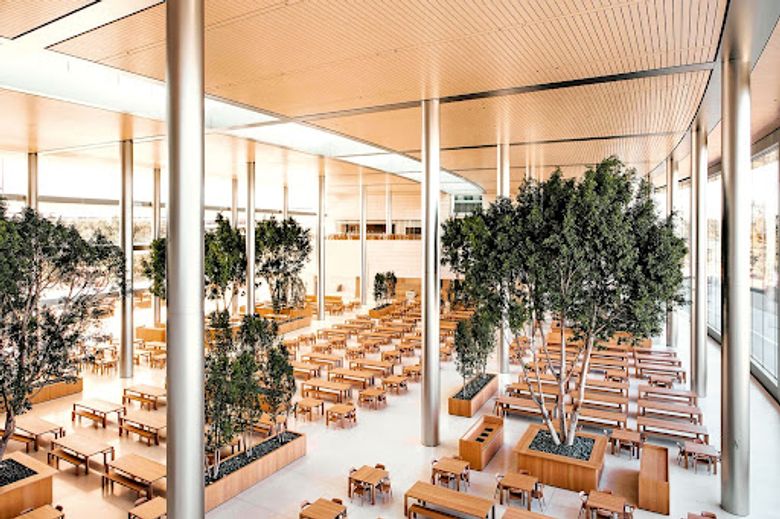
Photo credit: Arquitectura Viva
The 4,000-seat cafe is equipped with one of the biggest kitchens in the US, capable of serving 14,000 meals a day, made using food grown onsite wherever possible. In fact, Apple even has its own fishing boat to provide food for its workers.
However, unlike at Google and Facebook, the food at Apple is discounted rather than free.
“Apple subsidizes everything but the cost of ingredients so you can have custom sushi or pizza from scratch for less than $10,” one employee said. “Dinners are usually free for people on iOS or OS X teams.”
The Fitness and Wellness Center
This center is a pavilion retreat built around a courtyard shaded by olive trees. Inside is a juice bar that serves healthy drinks and snacks. The campus also features two basketball courts and a two-story yoga studio for desk jockeys to unwind.
The Steve Jobs Theater
The theater is a 1,000 seat, 165 ft-diameter glass rotunda where the iPhone X was first launched. What’s impressive about this building is that the carbon-fiber roof is supported entirely by the glass walls and weighs just 80 tons. The electricity, data, and sprinkler systems are concealed behind three, quarter-inch strips of aluminum in between the theater’s glass surrounds.
The theater is where Apple hosts its iconic product launches and other events. The campus also has onsite R&D facilities housed in two buildings, although little is known about what takes place behind its walls.
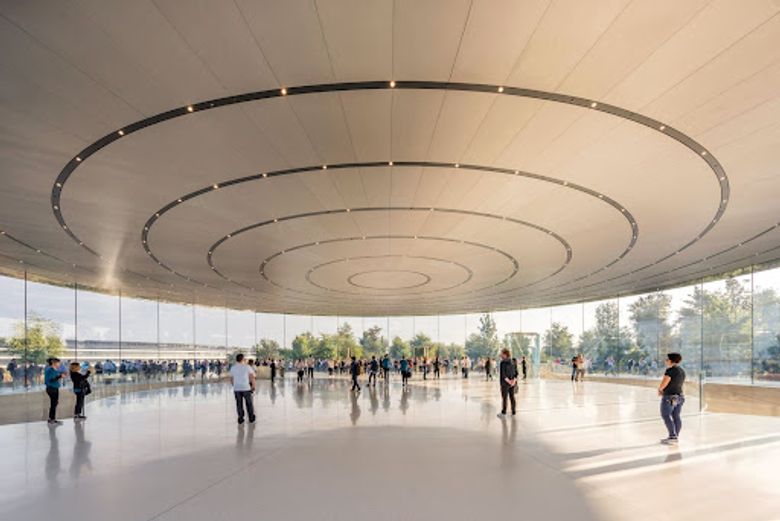
Photo credit: Arquitectura Viva
Before you plan a visit...
Unfortunately, the Apple campus isn’t open to the public. Yes, Jobs did posit once that The Ring’s design was so impressive that “architecture students will come here to see it,” but that doesn’t mean they can.
Non-employees can walk the perimeter of The Ring, but they can’t go inside or access the Steve Jobs Theater. However, a visitor’s center located across the street from the campus is open to the public. The center is essentially an Apple store, but it’s stocked with exclusive merchandise (Apple Park t-shirts and accessories you can’t get anywhere else), an AR experience that tells you more about the campus, and a cafe. You won’t find printed menus here: cafe menus are shown on an iPad.
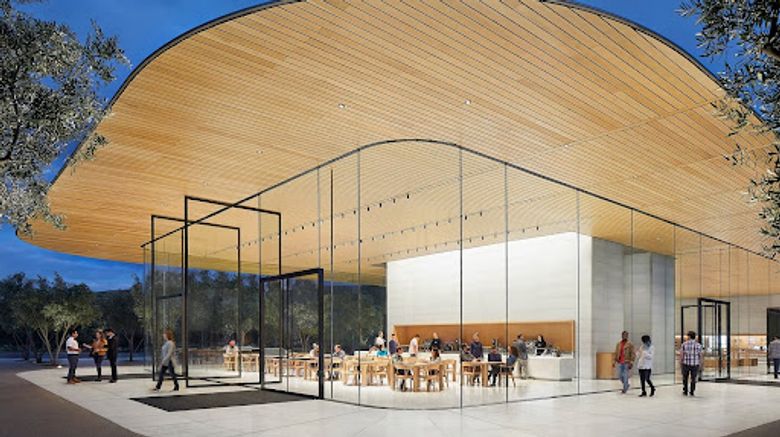
Photo credit: Apple
From the rooftop deck of the visitor’s center, you can get the best view of the Apple campus available to the public.
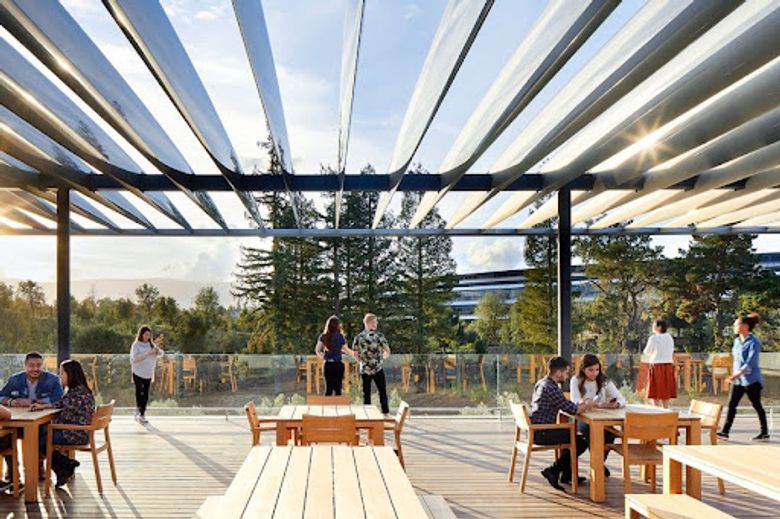
Photo credit: Architect Magazine
Apple’s employee perks
Despite notoriously long working hours and a culture of intense secrecy, Apple offers some of the best employee benefits in the industry.
- According to Glassdoor, Apple employees get an annual 25% discount when they purchase an iPod, computer, or iPad. Every three years, workers can get $250 off an iPad or $500 of a Mac. Apple software is 50% off.
- Employees get free beer and appetizers at the company’s beer bashes hosted in the quad, which are played by some of the biggest names in music. Previous acts include Stevie Wonder, Maroon 5, and Demi Lovato. In 2016, One Republic made a special appearance to celebrate the Mac’s 30th anniversary.
- Four weeks of paid leave before giving birth and 14 weeks after. Non-birth parents get six weeks of PTO.
- Shuttle bus service transport employees from parts of the Bay Area to its Cupertino campus. Apple also provides a stipend to help cover the cost of commuting by bus, train, and other public transportation. There are also 1,000 bikes available onsite to help employees get from one part of the campus to another.
- Fertility assistance covers the full cost of egg freezing, which can average anywhere from $6,000-$20,000.
- Unlimited free apples from its onsite fruit trees!
The information provided herein is for general informational purposes only and is not intended to provide tax, legal, or investment advice and should not be construed as an offer to sell, a solicitation of an offer to buy, or a recommendation of any security by Candor, its employees and affiliates, or any third-party. Any expressions of opinion or assumptions are for illustrative purposes only and are subject to change without notice. Past performance is not a guarantee of future results and the opinions presented herein should not be viewed as an indicator of future performance. Investing in securities involves risk. Loss of principal is possible.
Third-party data has been obtained from sources we believe to be reliable; however, its accuracy, completeness, or reliability cannot be guaranteed. Candor does not receive compensation to promote or discuss any particular Company; however, Candor, its employees and affiliates, and/or its clients may hold positions in securities of the Companies discussed.
